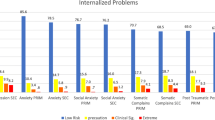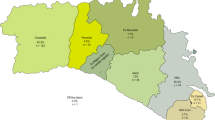Abstract
Objective
To determine high school pupils’ attitudes towards adolescents with special needs (for example: TS); to learn what they know about the symptomatology and the exceptional behavior of TS; and what they think about their social future.
Methods
Ninety-nine pupils participated in the study. Their mean age was 16.7±0.8 years. Forty-eight point five percent were boys, and the rest girls. They completed a questionnaire concerning knowledge and attitudes towards adolescents with special needs (diagnosed as TS). They had participated in lessons and class talks about handicapped children with psycho behavioral symptoms.
Results
The scores for their knowledge were at a level of 68.9%. Half of the pupils knew and responded correctly that TS was of genetic origin; but the most important: they expressed a comprehensive and tolerant attitude towards impaired behavior in TS at a level of 55.3%. The tolerant attitude increased with advancing age and with school grades. The attitudes were more comprehensive in families suffering form their own emotional or other psychiatric difficulties Forty-three point four percent of pupils understand and consider TS to be an emotional, behavioral and psychiatric entity. Sixty-two point six percent of pupils understand as well and believe that the disruptive behavior and outbursts in TS are involuntary and not under the adolescent’s control. On the other hand, a quarter of the pupils see justification for repeated punishment of TS adolescents for their impaired behavior. Fifty-six point six percent of regular pupils were ready to develop frienship with TS classmates in spite of their unexpect and unruly behaviour. Eight-three point eight percent of pupils believe it is better to inform teachers and classmates about the impaired behavior of, these TS adolescents. Concerning the future of these disabled adolescents, pupils scored a level of 44% for their optimistic beliefs about success in future life; 52% believe that in spite of all difficulties TS adolescents would be able to live an ordinary life, to raise a family and to work.
Conclusions
It is crucial to improve pupils’ attitudes in schools (as well as their teachers’) towards adolescents with special needs (including TS). The authors recommend that TS be considered as a neuro-behavioral and psychiatric disorder; it should be considred as a disability, which calls for comprehension, (not punishment). It would also be of value to speak in classes about the handicaps and neurobehaviorallimitations for example of these TS adolescents, as well as about other pupils in school with special needs, in order to behave socially correctly towards them. The final aim will be that pupils in school will learn to accept the different child and adolescent as they are.
Similar content being viewed by others
References
Leckman JF, Cohen DJ. Tourette’s syndrome: tics, obsessions, compulsions, develop∼ental psychopathology and clinical care. New York (NY):J. Wiley 1999; p. 338–359.
Como PG. Neuropsychological function in Tourette’s syndrome. Adv Neurol 2001; 85: 103–111.
Kurian R, Como PG, Miller B, Polumbo D, Deeley Cet al. The behavioral spectrum oftic disorders: a community-based study.Neurology 2002; 59: 414–420.
Moyano MB. Psychiatric Comorbidity in Clinical Samples.Vertex 2001; 12: 165–175.
Thibert AL, Day HI, Sandor P. Self-concept and selfconsciousness in adults with Tourette’s syndrome.Can J Psychiatry 1995; 40: 35–39.
Sukhodolsky DG, Scahill L, Zhang H, Peterson BS, King RA.et al. Disruptive behavior in children with Tourette’s syndrome: association with ADHD comorbidity, tic severity and functional impairment.J Am Acad Child Adolesc Psychiatry 2003; 42: 98–105.
Elstner K, Selai CE, Trimble MR, Robertson MM. Quality offife of patients with Gilles de la Tourette’s syndrome.Acta Psychiatr Scand 2001; 103: 52–59.
Hubka GB, Fulton WA, Shady GA, Champion LM, Wand R. TS impact on Canadian families functioning.Neurosci Biobehav Rev 1988; 12: 259–261.
Klassen AF, Miller A, Fine S. Health-related quality offife in children and adolescents who have a diagnosis of ADHD.Pediatrics 2004; 114: e541–547.
Kano Y, Ohta M, Nagai Y. Clinical characteristics of Tourette’s syndrome.Psychiatry Clin Neurosci 1998; 52: 51–57.
Fen CR, Barbosa ER, Miguel EC. Gilles de la Tourette’s syndrome: a clinical study on 58 cases.Arq Neuropsiquiatr 2001; 59: 729–732.
Zinner SH. Tourette’s disorder.Pediat in Review 2000; 21: 372–383.
Wodrich DL, Benjamin E, Lachar D. Tourette’s syndrome and psychopathology in a child psychiatry setting.J Am Acad Child Adolesc Psychiatry 1997; 36: 1618–1624.
Carter AS, Pauls DL, Leckman JF, Cohen DJ. A prospective longitudinal study of Gilles de la Tourette’s syndrome.Am Acad Child Adolesc Psychiatry 1994; 33: 377–385.
Step hence RJ, Sandor P. Aggressive behavior in children with TS and comorbid ADHO and OCD.Canad J Psychology 1999; 44: 1036–1042.
Freeman RD, Fast DK, Burd L, Kerboshian J, Robertson MM, Sandor P. An international perspective on TS: Selected, finding ITom 3500 individuals in 22 countries.Dev Med Child Neuro 2000; 42: 436–447.
Mathews CA, Waller J, Glidden D, Low TL, Herrera LD, Budman CL, Erenberg G, Naarden A, Bruun RD, Freimer NB Rens VI. Self injurious behavior in TS: Correlate with impulsivity and impuls control.J Neurol Psychiatry 2004; 75: 1149–1155.
Mason A, Banerjee S, Eapon V, Zeitlin H, Robertson M. The prevalence of Tourette’s syndrome in a mainstream schools population.Dev Med Child Neurol 1998; 40: 292–296.
Abwender DA, Como PG, Kurlan R Parry K, Feu KAet al. School problems in TS.Arch Neurol 1996; 53: 509–511.
Bawden HN, Stoocks A, Camphield PR, Salisbury S. Peer relationship problems in children with TS or DM.J Vhild Psychol Psychiatr 1998; 39: 663–668.
Comings DE, Comings BG. Tourette’s syndrome: clinical and psychological aspects of 250 cases.Am J Hum Genet 1985; 37: 435–450.
Schapiro NA. “Dude, you don’t have Tourette’s”: Tourette’s syndrome, beyond the tics.Pediatr Nurs 2002; 28: 243–246,249–253.
Comings DE, Comings BG. A controlled study of Tourette’s syndrome. II. Conduct.Am J Hum Genet 1987; 14: 742–760.
Vercueil L. Control ofiIll1er speech and Gille de la Tourette’s Syndrom.Encephale 2003; 29: 460–462.
Goldenberg IN, Brown SB, Weiner WI Coprolalia in younger patients with Gilles de la Tourette’s syndrome.Mov Disord 1994; 9: 622–625.
Robertson MM, Trimble MR, Lees AJ. Self-injurious behaviour and Gilles de la Tourette’s syndrome: a clinical study and review of literature.Psychol Med 1989; 19: 611–625.
AACAP: Understanding Violent Behavior in Children and Adolescents.Amer Acad of Child Adoles Psychiatry No. 55: Facts for Families.
Singer HS, Rosenberg LA. Development of behavioral and emotional problems in Tourette’s syndrome.Pediatr Neurol 1989; 5: 41–44.
Cohen DI Tourette’s syndrome: psychopathology of development in a model of neuropsychiatric dysfunction in children.Psychiatr Enfant 1992; 35: 365–419.
Peterson BS. Considerations of natural history and pathophysiology in the psychopharmacology of Tourette’s syndrome.J Clin Psychiatry 1996; 57 (Suppl 9):24–34.
Lindback T, Strand G. Tourette’s syndrome in children. An analysis of everyday problems—neurology or emotional conflicts?Tidsskr Nor Laegeforen 1994; 114: 2248–2251.
Lagiewka-Cook D, Goulet JL, Wand R, Shady G. Tourette’s syndrome: a psycho educational presentation.Axone 1993; 41: 89–91.
Dooley JM, Brna PM, Gordon KE. Parent perceptions of symptom severity in Tourette’s syndrome.Arch Dis Child 1999; 81: 440–441.
Coming DE, Coming BG. A controlled study of TS. 1. ADD, LD, and school problems.Am J Hum Genet 1987; 41: 701–741.
Kurlan R. Hypothesis 2: TS is part of a clinical spectrum that includes normal brain development.Arch Neurol 1994; 51: 1145–1150.
Budman CL, Bruun RD, Park KS, Olson ME. Rage attacks in children and adolescents with Tourette disease: a pilot study.J Clin Psychiatry 1998; 59: 576–580.
Stokes A, Bauden HN, Camfield PR, Backman JE, Dooley IM. Peer problems in Tourette’s disorder.Pediatrics 1991; 81: 936–942.
Friedrich S, Morgan SB, Devine C. Children’s attitude and behavioral intentions towards peer with TS.J Ped Psych 1996; 21: 307–319.
Champion LM, Fulton WA, Shady GA. T ourette’s syndrome and social functioning in a Canadian population.Neurosci Biobehav Rev 1988; 12: 255–257.
Budman CL, Bruun RD, Parks KS, Lesser M Olson M. Explosive outbursts in children with Tourette’s disorder.J Am Acad Child Adolesc Psychiatry 2000; 39: 1270–1276.
Shady GA, Fulton WA, Champion LM. Tourette’s syndrome and educational problems in Canada.Neurosci Biobehav Rev 1988; 12: 263–265.
Wang HS, Kuo MF. TS in Taiwan: en epidemiological study of tic disorders in an elementary school at Taipei Country.Brain Dev 2004; 25 suppl 1: s29–31.
Author information
Authors and Affiliations
Corresponding author
Rights and permissions
About this article
Cite this article
Brook, U., Boaz, M. Attitude and knowledge of high school pupils towards adolescents with special needs (tourette’s syndrome). Indian J Pediatr 73, 1099–1104 (2006). https://doi.org/10.1007/BF02763054
Issue Date:
DOI: https://doi.org/10.1007/BF02763054




